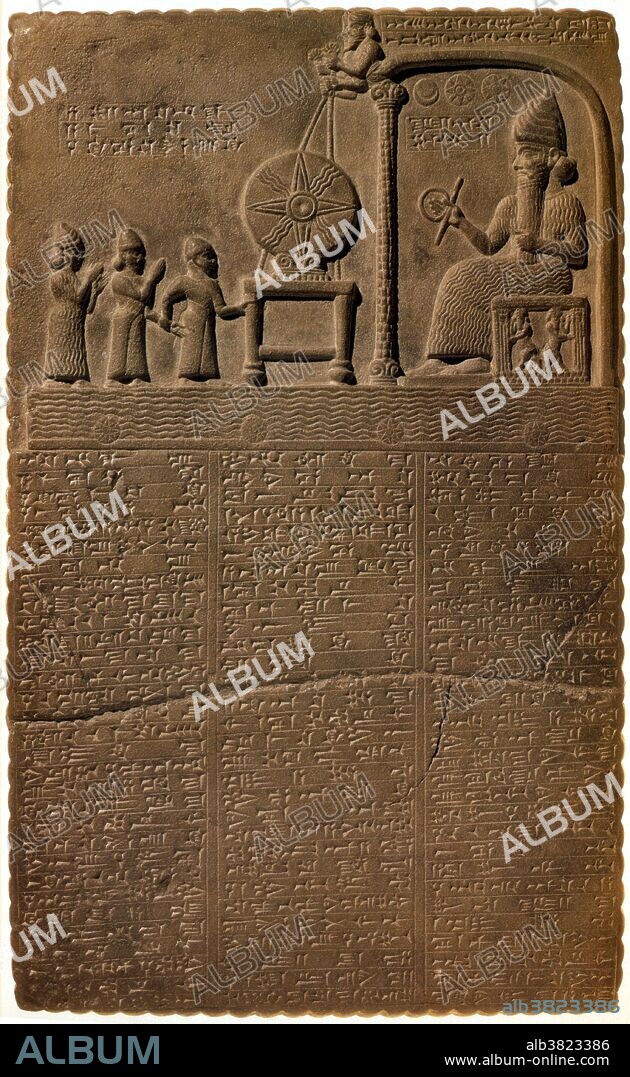alb3823386
Tablet of Shamash, 9th Century BC

|
Add to another lightbox |
|
Add to another lightbox |



Title:
Tablet of Shamash, 9th Century BC
Caption:
The Tablet of Shamash is a stone tablet recovered from the ancient Babylonian city of Sippar in southern Iraq in 1881. The bas-relief on the top of the obverse shows Shamash, the Sun God, beneath symbols of the Sun, Moon and Venus. He is depicted in a seated position in a shrine, holding forward a measuring rod and reel of cord. There is another large sun disk in front of him on an altar, suspended from above by two figures. Of the three other figures on the left, the central one is dressed in the same fashion as Shamash and is assumed to be the Babylonian king Nabu-apla-iddina receiving the symbols of deity. The cuneiform text beneath the stele is divided into fifteen passages, blending prose, poetic and rhetorical elements in the fashion typical of Mesopotamian royal inscriptions. It tells how Sippar and the Ebabbar temple of Shamash had fallen into disrepair with the loss of the statue of the God. This cult image is temporarily replaced with the solar disk; it is further described how a new figure of Shamash was found in an eastern part of the Euphrates, from which Nabu-apla-iddina has constructed a new statue of lapis lazuli and gold to restore the cult.
Personalities:
Credit:
Album / Science Source / New York Public Library
Releases:
Model: No - Property: No
Rights questions?
Rights questions?
Image size:
2927 x 4758 px | 39.8 MB
Print size:
24.8 x 40.3 cm | 9.8 x 15.9 in (300 dpi)
Keywords:
9TH CENTURY BC • 9TH CENTURY BCE • ACCADIAN ART • AKKADIA • AKKADIAN • ANCIENT CIVILIZATION • ANCIENT CULTURE • ANCIENT • ANTIQUITY • ARCHAEOLOGICAL • ARCHAEOLOGY • ARCHEOLOGICAL • ART • ARTIFACT • ARTWORK • ASSYRIA • ASSYRIAN • BABYLON • BABYLONIA • BAS RELIEF • BAS-RELIEF • BASRELIEF • CLAY TABLET • CRADLE OF CIVILIZATION • CUNEIFORM CHARACTERS • CUNEIFORM INSCRIPTION • CUNEIFORM SCRIPT • CUNEIFORM TABLET • DEITY • GOD OF JUSTICE • GOD • HISTORIC • HISTORICAL • HISTORY • IRAQ • LOW RELIEF • MESOPOTAMIA • MESOPOTAMIAN • PANTHEON • RELIEF • RELIEVO RILIEVO • RELIGION • RELIGIOUS • SCULPTURE • SHAM ASH • SIPPAR • STONE TABLET • STYLIZED SYMBOLS • SUN GOD • TABLET OF SHAMASH • TABLET • TEXT • WRITING SYSTEM
 Pinterest
Pinterest Twitter
Twitter Facebook
Facebook Copy link
Copy link Email
Email

